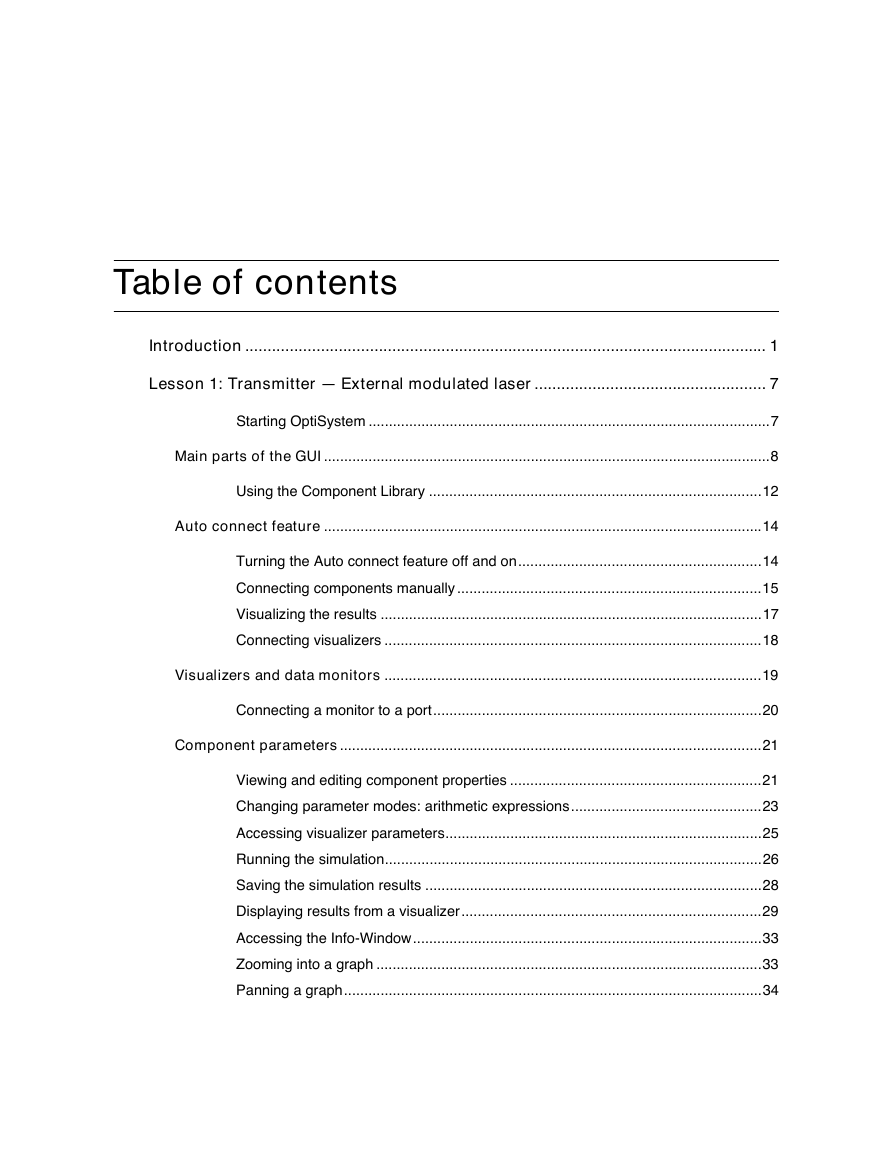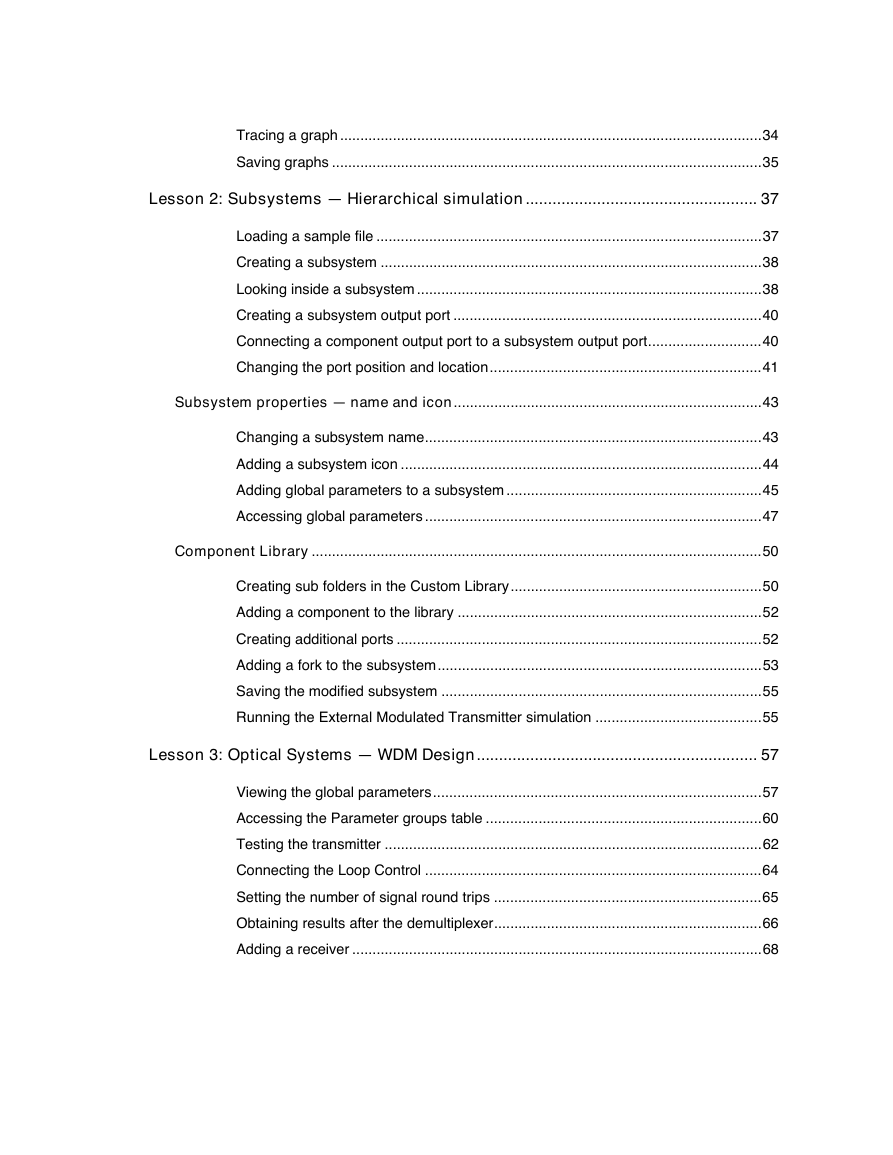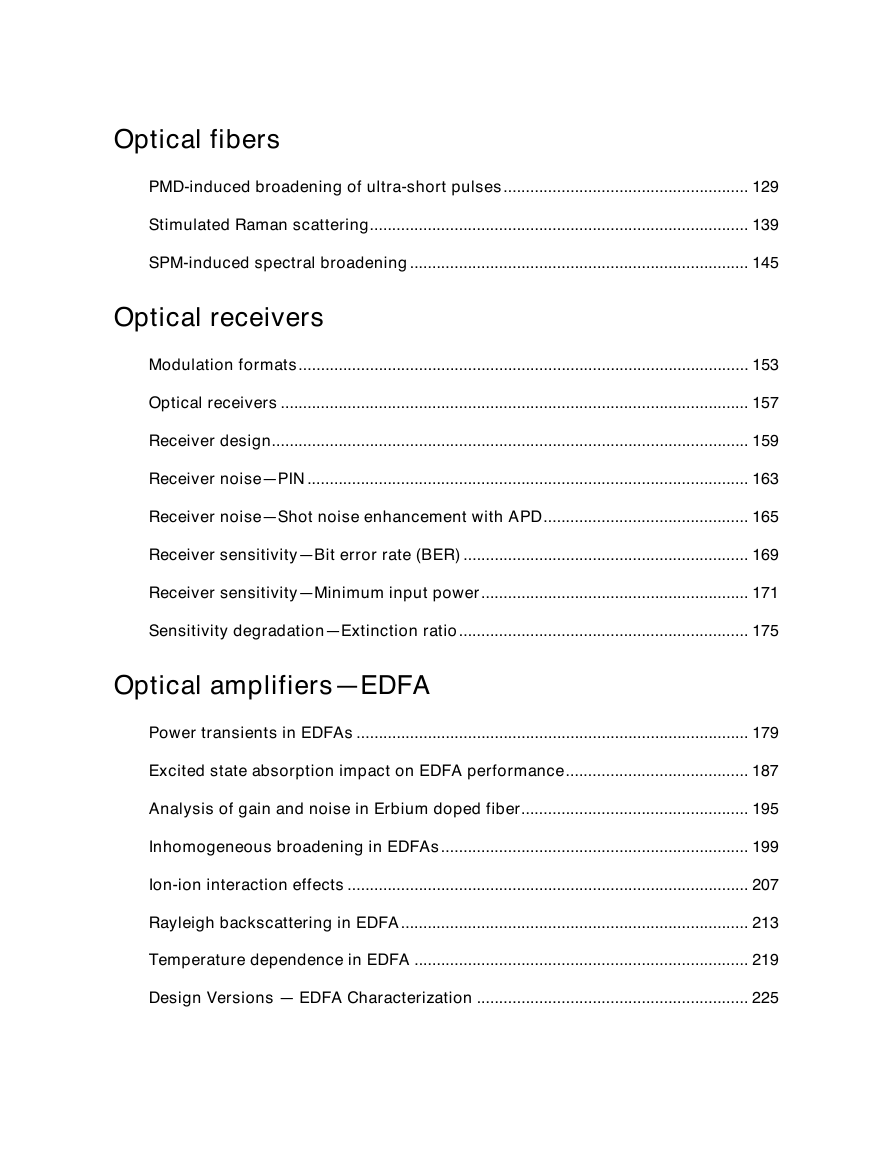Table of contents
Introduction
Tutorials
Advanced simulation project sections
IMPORTANT
Notes
Notes:
Lesson 1: Transmitter — External modulated laser
Main parts of the GUI
Project layout
Dockers
Status Bar
Menu bar
Auto connect feature
Visualizing the results
Visualizers and data monitors
Component parameters
Display parameters in the layout
Parameter units
Info-Window
Zoom, Pan, and Trace tools
Lesson 2: Subsystems — Hierarchical simulation
Subsystem properties — name and icon
Component Library
Lesson 3: Optical Systems — WDM Design
Global parameters
Transmitters
Parameter groups
Fiber + EDFA spans
BER Analyzer
Notes:
Lesson 4: Parameter Sweeps — BER x Input power
Optical transmitters
Notes:
Lightwave system components
Optical transmitters
Communication channel
Optical receivers
Receiver design
LED modulation response
References
Semiconductor laser modulation response
References
Semiconductor laser—Large signal modulation
References:
Chirp in Mach-Zehnder Lithium Niobate modulators
References:
LED spectral distribution
References
Semiconductor laser L-I curve
Laser noise and linewidth
Notes:
Optical fibers
Notes:
PMD-induced broadening of ultra-short pulses
References:
Stimulated Raman scattering
References
SPM-induced spectral broadening
References:
Optical receivers
Notes:
Modulation formats
Notes:
Optical receivers
Receiver design
Notes:
Receiver noise—PIN
Receiver noise—Shot noise enhancement with APD
Notes:
Receiver sensitivity—Bit error rate (BER)
Receiver sensitivity—Minimum input power
Notes:
Sensitivity degradation—Extinction ratio
Optical amplifiers—EDFA
Notes:
Power transients in EDFAs
References:
Excited state absorption impact on EDFA performance
References:
Analysis of gain and noise in Erbium doped fiber
Reference:
Inhomogeneous broadening in EDFAs
References
Notes:
Ion-ion interaction effects
Homogeneous Upconversion
Pair-Induced Quenching
References:
Rayleigh backscattering in EDFA
References:
Temperature dependence in EDFA
References:
Design Versions — EDFA Characterization
SPO optimization—System margin
SPO optimization—EDFA fiber length
Notes:
EDFA — Basic concepts
Layout Gain Spectrum
Layout Gain Saturation
Layout Amplifier Noise
Notes:
Booster Amplifier
Notes:
Inline Amplifier
Notes:
Preamplifier
Pumping requirements
Raman amplifiers
Notes:
100 nm bandwidth flat�gain Raman amplifier— Average power model
References:
Raman Amplifier - Dynamic Model
Reference:
Notes:
Hybrid
Design of a broadband Raman amplifier using subsystems
Definition of Multi-line source
Defining of Multi-line source subsystem
Designing a broadband gain-flattened Raman amplifier
Using the interactive 3D graphics
SOA amplifiers
Notes
SOA gain saturation—Gaussian pulses
References
SOA gain saturation—Comparison with experimental results
References
SOA gain saturation—Chirped and super Gaussian pulses
Saturation of amplification of chirped Gaussian pulse
Saturation of amplification of super Gaussian pulse
References
SOA Gaussian Pulse — Gain Recovery
SOA parameters
The partial gain recovery
The complete gain recovery (the quasi CW operation)
Appearance of gain-saturation induced self-phase modulation
References
SOA Pulse Compression
References
Notes
SOA as a Wavelength Converter (FWM)
References
SOA as a Wavelength Converter (XGM)
References
Notes
SOA In-line Amplifier
References
Waveguide amplifiers
Notes:
Improved gain gharacteristics in high- concentration Er3+/Yb3+ codoped glass waveguide amplifiers
References
Notes:
Dispersion management
Notes:
Dispersion compensation schemes—a system perspective
Pre-, post-, and symmetrical-compensation by using DCF
Dispersion compensation by using DCM
References:
Compensation of dispersion with ideal dispersion component
Compensation of dispersion with Fiber Bragg Grating component
Notes:
Uniform Fiber Bragg Grating as a filter
References
Compensation of dispersion with OptiGratings
References
Dispersion compensation using subsystems and scripting
Lightwave systems
Notes:
Optimizing the power and dispersion compensation for nonlinear RZ transmission
References:
Limitations on the bit rate
Optical sources with a small spectral width
Optical sources with a large spectral width
References
10 Gb/s single channel transmission in standard mode fibers (SMF)
References
40 Gb/s single channel transmission in standard mode fibers (SMF)
References:
Engineering the fiber nonlinearities and dispersion
Single channel system
Multi-channel system
References
System design — Power budget
Time Division Multiplexing (TDM)
Preamplifier system
Booster system
WDM systems
Notes:
WDM Components—Tunable filters
Fabry-Perot filters
Uniform FBG Filters
WDM components—AWG demultiplexer
Notes:
Broadcast star coupler
Optical cross-connects
Notes:
Time division multiplexing
Notes:
Solitons and soliton systems
Solitons
Soliton systems
Notes:
Fundamental and higher order solitons
Reference
Interactions of optical solitons
Reference:
Decay of higher order solitons in the presence of intrapulse Raman scattering
Reference:
Orthogonal Raman gain
References
Stability of solitons in birefringent optical fibers
References:
Influence of third-order dispersion on solitons
References
Average soliton regime
References
Metro systems
Notes:
Interchannel crosstalk in Metro networks
References:
Migrating to 10Gbps in Metro networks
No dispersion compensation
"Per span" dispersion compensation
"Lumped" dispersion compensation
References
Negative dispersion fiber for Metro networks
Modeling Directly Modulated Lasers
Transmission Characteristics of DMLs
Transmission at higher bit rates
32 Channel DWDM system simulation at 2.5 Gbps
References
Power level management in optical Metro networks
Design without amplification
Self-Phase Modulation
Cross-Phase Modulation
Four-Wave Mixing
Design with Lumped Amplification
Optical Amplifier
Unity Gain Design
Considering the Non-Ideal Characteristics of EDFAs
References:
WDM Ring—Wavelength independent subscriber equipment
References
















 2023年江西萍乡中考道德与法治真题及答案.doc
2023年江西萍乡中考道德与法治真题及答案.doc 2012年重庆南川中考生物真题及答案.doc
2012年重庆南川中考生物真题及答案.doc 2013年江西师范大学地理学综合及文艺理论基础考研真题.doc
2013年江西师范大学地理学综合及文艺理论基础考研真题.doc 2020年四川甘孜小升初语文真题及答案I卷.doc
2020年四川甘孜小升初语文真题及答案I卷.doc 2020年注册岩土工程师专业基础考试真题及答案.doc
2020年注册岩土工程师专业基础考试真题及答案.doc 2023-2024学年福建省厦门市九年级上学期数学月考试题及答案.doc
2023-2024学年福建省厦门市九年级上学期数学月考试题及答案.doc 2021-2022学年辽宁省沈阳市大东区九年级上学期语文期末试题及答案.doc
2021-2022学年辽宁省沈阳市大东区九年级上学期语文期末试题及答案.doc 2022-2023学年北京东城区初三第一学期物理期末试卷及答案.doc
2022-2023学年北京东城区初三第一学期物理期末试卷及答案.doc 2018上半年江西教师资格初中地理学科知识与教学能力真题及答案.doc
2018上半年江西教师资格初中地理学科知识与教学能力真题及答案.doc 2012年河北国家公务员申论考试真题及答案-省级.doc
2012年河北国家公务员申论考试真题及答案-省级.doc 2020-2021学年江苏省扬州市江都区邵樊片九年级上学期数学第一次质量检测试题及答案.doc
2020-2021学年江苏省扬州市江都区邵樊片九年级上学期数学第一次质量检测试题及答案.doc 2022下半年黑龙江教师资格证中学综合素质真题及答案.doc
2022下半年黑龙江教师资格证中学综合素质真题及答案.doc